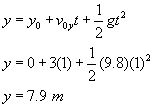 Free Fall Problem Solving Self-Check
Free Fall Problem Solving Self-Check
Let’s look at the more difficult problems dealing with free fall—objects thrown with an initial velocity. Try to work these out, and then click on the question to review the explanation.
Initial downward velocity
Suppose a ball is thrown downward from a 70-m tall tower at 3.00 m/s.
What is the ball’s position after 1.0 second? 2.0 seconds?
Using the equation
|
What is the ball’s velocity after 1.0 second? 2.0 seconds?
Using the equation for velocity v = vO + gt, substitute the correct values in and solve for velocity.
|
|
|
How long will it take the ball to reach the ground?
For time, we must use the position equation
Notice here you will have TWO solutions. Use your knowledge of solving quadratics for roots to solve. The roots of the equation are 3.49 and –4.10. Since time cannot be negative, the only logical answer is 3.49 seconds. |
 For more practice, solve the following problems from “Chapter 2, Problems” at the end of the chapter. The answers are in the back of your book.
For more practice, solve the following problems from “Chapter 2, Problems” at the end of the chapter. The answers are in the back of your book.
Problems # 33, 35, 37, 39, 41 (extra challenge—43, 45, 47)




